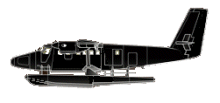
ASN Wikibase Occurrence # 323399
| Date: | Wednesday 1 November 2000 |
| Time: | 15:10 |
| Type: |  de Havilland Canada DHC-6 Twin Otter 100 |
| Owner/operator: | West Coast Air |
| Registration: | C-GGAW |
| MSN: | 86 |
| Year of manufacture: | 1967 |
| Engine model: | Pratt & Whitney Canada PT6A-20 |
| Fatalities: | Fatalities: 0 / Occupants: 17 |
| Aircraft damage: | Destroyed, written off |
| Category: | Accident |
| Location: | Vancouver-Coal Harbour, BC -
 Canada Canada
|
| Phase: | Initial climb |
| Nature: | Passenger - Scheduled |
| Departure airport: | Vancouver-Coal Harbour SPB, BC (CXH/CYHC) |
| Victoria Harbour, BC | |
| Investigating agency: | TSB |
| Confidence Rating: |
The West Coast Air Twin Otter floatplane departed Vancouver-Coal Harbour around 15:10 for a scheduled 35-minute flight to Victoria Harbour. Soon after takeoff, at a height of 50-100 feet, the no. 2 engine failed. The aircraft struck the water about 25 seconds later in a nose-down, right wing-low attitude. The right-hand float and wing both detached from the fuselage at impact. The occupants managed to clamber onto the aircraft's pontoon and wing. Rescue boats, including a SeaBus passenger ferry, responded quickly to evacuate the passengers and crew from the plane.
FINDINGS AS TO CAUSES AND CONTRIBUTING FACTORS:
1. A planetary gear disintegrated in the propeller reduction gearbox of the No 2 engine and caused the engine drive shaft to disconnect from the propeller, resulting in a loss of propulsion from this engine.
2. The planetary gear oil strainer screen wires fractured by fatigue as a consequence of the installation at the last overhaul. This created an unsafe condition and it is most probable that the release of wire fragments and debris from this strainer screen subsequently initiated or contributed to distress of the planetary gear bearing sleeve and resulted in the disintegration of the planetary gear.
3. Although airspeed was above Vmc at the time of the power loss, the aircraft became progressively uncontrollable due to power on the remaining engine not being reduced to relieve the asymmetric thrust condition until impact was imminent.
Accident investigation:
 |
|
Sources:
Images:

photo (c) Michael Moore; Victoria Harbour, BC; 1996

photo (c) Michael Moore; Victoria Harbour, BC; 1996
Revision history:
| Date/time | Contributor | Updates |
|---|
The Aviation Safety Network is an exclusive service provided by:


 ©2024 Flight Safety Foundation
©2024 Flight Safety Foundation